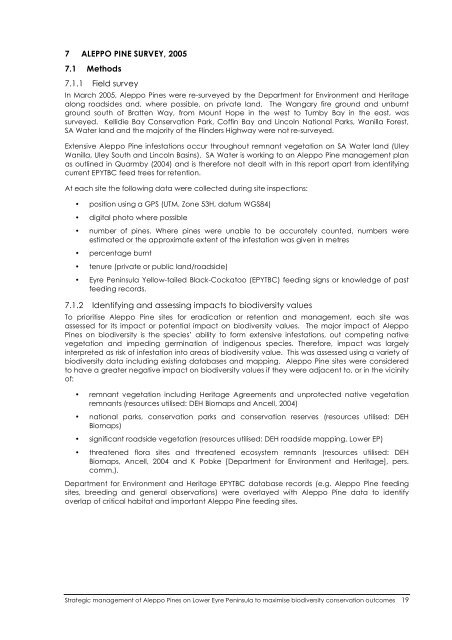Strategic management of Aleppo Pines on Lower Eyre
Strategic management of Aleppo Pines on Lower Eyre
Strategic management of Aleppo Pines on Lower Eyre
You also want an ePaper? Increase the reach of your titles
YUMPU automatically turns print PDFs into web optimized ePapers that Google loves.
7 ALEPPO PINE SURVEY, 2005<br />
7.1 Methods<br />
7.1.1 Field survey<br />
In March 2005, <str<strong>on</strong>g>Aleppo</str<strong>on</strong>g> <str<strong>on</strong>g>Pines</str<strong>on</strong>g> were re-surveyed by the Department for Envir<strong>on</strong>ment and Heritage<br />
al<strong>on</strong>g roadsides and, where possible, <strong>on</strong> private land. The Wangary fire ground and unburnt<br />
ground south <str<strong>on</strong>g>of</str<strong>on</strong>g> Bratten Way, from Mount Hope in the west to Tumby Bay in the east, was<br />
surveyed. Kellidie Bay C<strong>on</strong>servati<strong>on</strong> Park, C<str<strong>on</strong>g>of</str<strong>on</strong>g>fin Bay and Lincoln Nati<strong>on</strong>al Parks, Wanilla Forest,<br />
SA Water land and the majority <str<strong>on</strong>g>of</str<strong>on</strong>g> the Flinders Highway were not re-surveyed.<br />
Extensive <str<strong>on</strong>g>Aleppo</str<strong>on</strong>g> Pine infestati<strong>on</strong>s occur throughout remnant vegetati<strong>on</strong> <strong>on</strong> SA Water land (Uley<br />
Wanilla, Uley South and Lincoln Basins). SA Water is working to an <str<strong>on</strong>g>Aleppo</str<strong>on</strong>g> Pine <str<strong>on</strong>g>management</str<strong>on</strong>g> plan<br />
as outlined in Quarmby (2004) and is therefore not dealt with in this report apart from identifying<br />
current EPYTBC feed trees for retenti<strong>on</strong>.<br />
At each site the following data were collected during site inspecti<strong>on</strong>s:<br />
• positi<strong>on</strong> using a GPS (UTM, Z<strong>on</strong>e 53H, datum WGS84)<br />
• digital photo where possible<br />
• number <str<strong>on</strong>g>of</str<strong>on</strong>g> pines. Where pines were unable to be accurately counted, numbers were<br />
estimated or the approximate extent <str<strong>on</strong>g>of</str<strong>on</strong>g> the infestati<strong>on</strong> was given in metres<br />
• percentage burnt<br />
• tenure (private or public land/roadside)<br />
• <strong>Eyre</strong> Peninsula Yellow-tailed Black-Cockatoo (EPYTBC) feeding signs or knowledge <str<strong>on</strong>g>of</str<strong>on</strong>g> past<br />
feeding records.<br />
7.1.2 Identifying and assessing impacts to biodiversity values<br />
To prioritise <str<strong>on</strong>g>Aleppo</str<strong>on</strong>g> Pine sites for eradicati<strong>on</strong> or retenti<strong>on</strong> and <str<strong>on</strong>g>management</str<strong>on</strong>g>, each site was<br />
assessed for its impact or potential impact <strong>on</strong> biodiversity values. The major impact <str<strong>on</strong>g>of</str<strong>on</strong>g> <str<strong>on</strong>g>Aleppo</str<strong>on</strong>g><br />
<str<strong>on</strong>g>Pines</str<strong>on</strong>g> <strong>on</strong> biodiversity is the species’ ability to form extensive infestati<strong>on</strong>s, out competing native<br />
vegetati<strong>on</strong> and impeding germinati<strong>on</strong> <str<strong>on</strong>g>of</str<strong>on</strong>g> indigenous species. Therefore, impact was largely<br />
interpreted as risk <str<strong>on</strong>g>of</str<strong>on</strong>g> infestati<strong>on</strong> into areas <str<strong>on</strong>g>of</str<strong>on</strong>g> biodiversity value. This was assessed using a variety <str<strong>on</strong>g>of</str<strong>on</strong>g><br />
biodiversity data including existing databases and mapping. <str<strong>on</strong>g>Aleppo</str<strong>on</strong>g> Pine sites were c<strong>on</strong>sidered<br />
to have a greater negative impact <strong>on</strong> biodiversity values if they were adjacent to, or in the vicinity<br />
<str<strong>on</strong>g>of</str<strong>on</strong>g>:<br />
• remnant vegetati<strong>on</strong> including Heritage Agreements and unprotected native vegetati<strong>on</strong><br />
remnants (resources utilised: DEH Biomaps and Ancell, 2004)<br />
• nati<strong>on</strong>al parks, c<strong>on</strong>servati<strong>on</strong> parks and c<strong>on</strong>servati<strong>on</strong> reserves (resources utilised: DEH<br />
Biomaps)<br />
• significant roadside vegetati<strong>on</strong> (resources utilised: DEH roadside mapping, <strong>Lower</strong> EP)<br />
• threatened flora sites and threatened ecosystem remnants (resources utilised: DEH<br />
Biomaps, Ancell, 2004 and K Pobke [Department for Envir<strong>on</strong>ment and Heritage], pers.<br />
comm.).<br />
Department for Envir<strong>on</strong>ment and Heritage EPYTBC database records (e.g. <str<strong>on</strong>g>Aleppo</str<strong>on</strong>g> Pine feeding<br />
sites, breeding and general observati<strong>on</strong>s) were overlayed with <str<strong>on</strong>g>Aleppo</str<strong>on</strong>g> Pine data to identify<br />
overlap <str<strong>on</strong>g>of</str<strong>on</strong>g> critical habitat and important <str<strong>on</strong>g>Aleppo</str<strong>on</strong>g> Pine feeding sites.<br />
<str<strong>on</strong>g>Strategic</str<strong>on</strong>g> <str<strong>on</strong>g>management</str<strong>on</strong>g> <str<strong>on</strong>g>of</str<strong>on</strong>g> <str<strong>on</strong>g>Aleppo</str<strong>on</strong>g> <str<strong>on</strong>g>Pines</str<strong>on</strong>g> <strong>on</strong> <strong>Lower</strong> <strong>Eyre</strong> Peninsula to maximise biodiversity c<strong>on</strong>servati<strong>on</strong> outcomes 19

















